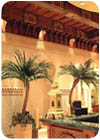
The 32,000-square-foot Elemis Spa at the Aladdin Resort & Casino in Las Vegas, NV, features stone and tile materials that reflect the colors and design of the region of Marrakech, Morocco. The goal of the project was to provide a “haven of calmness†on the Las Vegas Strip, according to John Picken, Managing Director of Stephenjohn Design Ltd.
Designer: Stephenjohn Design Ltd., London, U.K.; Stone Supplier: Dal-Tile Corp., Dallas, TX; Tile Suppliers: Pedro Beltran S.A., Bonares, Spain; (Moroccan wall tile); Ocra (non-slip ceramic tile); Stone Installer: T. Nickolas Co., Las Vegas, NV; General Contractor: Penta Building Group, Las Vegas, NV
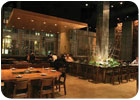
When designing EN Japanese Brasserie, a 6,500-square-foot high-end customary Japanese restaurant located in Greenwich Village in New York, NY, architects selected St. Baudille - a creamy tan limestone with a honed finished - as flooring throughout the main dining area. In addition, the rear wall of the restaurant features approximately 1,500 square feet of Basaltina. Architect: Kushner Studios Architecture and Design, P.C., New York, NY; Interior Designer: Age Designs Ltd., Tokyo, Japan; Stone Suppliers: Stone Source, New York, NY (St. Baudille limestone, Basaltina, Pompeii basalt stone); ABC Worldwide, Brooklyn, NY (Absolute Black granite)
With so many options in stone and tile products available today, the look and feel of hospitality design is reaching new levels. These materials are creating dazzling and chic environments, which attract patrons and make their stay or service memorable.
And although establishments such as restaurants, spas and hotels are exhibiting new and exciting high-end designs, there are also new avenues for premium material usage in the hospitality sector. The design of large-scale sports venues such as major stadiums and arenas has been enjoying a design renaissance for more than a decade, and they are now including tile and stone as part of the overall aesthetic.
Regardless of the type of service or style influences, the numerous stone and tile collections on today's market allow for unique and intriguing designs - no matter what the desired look.
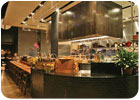
Additionally, a total of 100 square feet of Absolute Black granite from ABC Worldwide in Brooklyn, NY, was used for countertops in the fountain and the soup areas as well as the main dining space of the restaurant. A black tile - known as “debris recycled ceramic tile†from California - was also used to clad the front of the kitchen counter area.
A Moroccan Oasis
An example of how stone and tile was used to develop an exotic and sensual experience - while also reflecting cultural traditions - can be found at the Elemis Spa at the Aladdin Resort & Casino in Las Vegas, NV. In designing the 32,000-square-foot spa, John Picken, Managing Director of Stephenjohn Design Ltd., and his team, selected stone and tile to create an oasis where the mind, body and spirit could be refreshed in unsurpassed luxury.“Our task was to design a comprehensive spa facility, creating an escapism for the guests based on the exotic Rhyad's of Marrakech, Morocco,†Picken explained. “[Also] to capture the exquisite richness of color, sound and the aromatic fragrances, providing a haven of calmness on the Las Vegas Strip. “
The overall planning style of the facility is based on the “Souk†- having a ceramic tiling laid to various arrangements to simulate the sun scorched earth and spiced colors,†he continued.
A combination of Calcutta Gold marble with decorative inset borders was used for flooring at the entrance approach and reception areas, providing a sophisticated elegance, according to the architect. Additionally, the countertops in the reception area feature Verde Antique marble. Dal-Tile Corp. of Dallas, TX, supplied both materials. Moreover, decorative wall tiling is featured at the entrance, reception and whirlpool areas of the spa. According to Picken, the wall tiling is symbolic of the Moroccan ceramic art of “Zillij,†which features geometric patterns in contrast to the warm earthy tones and textures of the walls. The designer also explained that inset Zillij wall tiling was used for the Moorish arched recesses to add an artistic elegance. Pedro Beltran S.A. of Bonares, Spain, supplied the specialized Moroccan wall tiling.
Additionally, 18,000 square feet of non-slip ceramic tiling - from Ocra's Classic Collection - is used as flooring throughout the corridors and courtyards, as well as in the changing, shower and whirlpool areas. “All materials were selected to represent the best of Marrakech; typical colors and design of the region,†he said. “The materials also play an important role in health and safety, providing modern day requirements, yet holding a feel of the past.â€
According to Picken, consideration was given to many different tiles, “but, as with all projects, cost and availability play an important part in the selection process.â€
Colors of rich cobalt blue, burgundy, yellow and orange were selected to reflect Moroccan architecture, and according to Picken, earthy color choices were made to add natural warmth to the spa.
Picken said they purchased a handmade 'tree of life' ceramic panel for the main arched feature in the reception area, but it was destroyed during transportation from Morocco to Las Vegas.
“Criteria given by the client was to make a commitment to the Moroccan style, using modern materials, but not to compromise the romance and splendor of the environment,†the designer explained. “The client was passionate about Moroccan influence, giving a positive direction of their aspirations. Having expressed these wishes, they were gracious enough to trust Stephenjohn Design's skill and talents to select all materials considered suitable.â€
Since its completion, Elemis Spa has received rave reviews, according to Picken. “The Elemis Spa at Aladdin Hotel, has been awarded the accolade of 'Best Casino Hotel Spa' in Las Vegas by SpaFinder magazine, and has been featured in 'The Worlds Best 100 Spas' and numerous other publications,†he said.
Speaking on trends in general, Picken feels design options tend to lean towards natural-looking materials. “The Asian style is still popular with the 'ZEN' look, but now concepts are moving on,†he explained. “We are being requested to provide contemporary style with a Moorish and classical language. But the world is our master.†Furthermore, Picken feels that stone and tile are often added to a space “to preserve the look and feel of 'quality', ease of maintenance and durability, plus the elegance and sophistication.â€
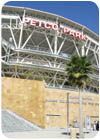
The new stadium for baseball's San Diego Padres - dubbed PETCO Park - was designed using 160,000 square feet of sandstone from India. The new stone, which was given the name “Padre Gold,†was supplied through Stone A.V. USA, Inc., of Plano, TX. Design Architect: Antoine Predock, Albuquerque, NM; Executive Architect: HOK Sport + Venue + Event, Kansas City, MO; Landscape Architect: Andrew Spurlock Martin Poirier, San Diego, CA; Stone Suppliers: Stone A.V. USA Inc., Plano, TX; Modern Builders Supply, San Marcos, CA; General Contractor: San Diego Ballpark Builders (A Joint Venture between Clark Construction Group, LLC, Roel Construction and douglas e. barnhard inc.); Development Manager: Hines Development, San Diego, CA
Adhering to Japanese Tradition
When designing EN Japanese Brasserie, a 6,500-square-foot high-end Japanese restaurant located in Greenwich Village in New York, NY, Adam Kushner of Kushner Studios Architecture and Design, P.C., also was influenced by cultural tradition. “The design goal was to create a series of spaces that were modern, yet carry the lines and vocabulary of traditional Japanese country style,†said Kushner. “This juxtaposition is also indicative of the food itself, where we find modern presentation of traditional Japanese country dining. So, for example, you may find the traditional wood screens set within a modern steel screen wall, or you may find traditional icons of Japanese life - sake cask covers, glazed roof tiles set in a wall of stone, etc.â€According to Project Architect Beau Simons, also of Kushner Studios Architecture and Design, P.C., the floor of the dining area is comprised of 1,700 square feet of St. Baudille - a creamy tan limestone with a honed finished - while the rear wall of the restaurant features approximately 1,500 square feet of Basaltina - a basalt quarried in the Latium region of Italy.
Stone was also carried into the bar/lounge area, where 1,200 square feet of Pompeii - a basalt stone from Asia - was used for the flooring in what is referred to as a Scarpaletta finish, which means “scratched.†Stone Source of New York, NY, supplied the material. In addition, a total of 100 square feet of Absolute Black granite - supplied by ABC Worldwide of Brooklyn, NY - was used for countertops in the fountain and the soup areas as well as the main dining area of the restaurant. A black tile was also used to clad the front of the kitchen counter, and Simons refers to the material as “debris recycled ceramic tile†from California.
Kushner said that the stone material represented sensuality, texture and permanence, as it does in traditional Japanese design. “These textures play off against other materials such as wood or steel or even cultural artifacts as noted above,†the architect explained. “The stone is a backdrop to the theatrics and rituals of dining, acting as a silent but imposing curtain. Its presence is meant to be one of an understated power.â€
As long as the material fit the budget and achieved the designers' goals, the architects were given a fairly free range on material selection, explained Kushner. “The Japanese interior designer, Ichiro Sato of Age Designs Ltd. of Tokyo, Japan, would dictate color, and our job as architects and contractors for the job was to find what we could get locally,†said the architect. “Most decisions involved the requirements I set forth above. Timing and availability of course played a factor in our final selections as well.â€
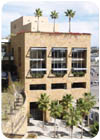
Away from the seating bowl, a series of stone-clad “garden buildings†house facilities such as office space, concessions and lounges.
Striking Gold in San Diego
When it was time to build a new stadium for baseball's San Diego Padres, the owners and architects wanted to capitalize on the city's favorable natural climate. As such, the stadium is arranged as an open air “garden†of sorts, allowing fans premium views of the field while also enjoying the beauty of the surrounding environment. And to enhance the stadium experience, premium materials such as Indian sandstone were selected to reflect the Torrey Pines cliffs of the San Diego coastline.The executive architect for the stadium - dubbed PETCO Park - was HOK Sport, and the design architect was Antoine Predock. “The new ballpark for San Diego and the San Diego Padres is a landmark for downtown and the city of San Diego,†said Predock. “[It] serves as a civic meeting place and a focus for the future development of downtown. The ballpark completes the connection between Balboa Park and the bay, acting as a grand terminus on the park-to-bay link.â€
From the very beginning, Predock wanted the ballpark to provide an environment where visitors could enjoy the outdoors at all times. “Taking full advantage of the San Diego climate, the new ballpark is most aptly described as a 'garden' that weaves in and out of every aspect of the design, from the concession stands to outdoor view terraces, from the seating bowl to the main concourse,†said Predock. “Traditionally, ballparks consisted of the seating bowl and a large facade that wrapped the perimeter of the concourse. “However, the design of the new ballpark has displaced the programmatic content, such as office space, concessions and lounges, away from the back of the bowl, creating an interstitial exterior space for the concourses to carve through with bridges connecting the two sides,†Predock continued. “As one circulates horizontally along the concourses, there is a reciprocal movement from a canyon-like space to peel away to open views beyond.â€
“The design of the new San Diego Padres ballpark is a metaphor for the City of San Diego,†stated a project description released by HOK Sport. “San Diego's hills, canyons and hilltops are brought to life and expressed in the new ballpark. Canyons are created by pulling the concessions and other ballpark facilities away from the seating bowl, and housing these facilities in stone-clad “garden buildings.†The garden buildings have outdoor patios and are terraced, creating a sense of natural hills. The canyons between the seating bowl and garden buildings are crossed by pedestrian bridges, akin to the bridges that criss-cross the city. These 'canyons' allow sunlight to stream into the lower concourses.â€
To clad the ballpark's feature elements, the owners and architects selected 160,000 square feet of Indian sandstone, a material that Predock had also used for other projects over the years. But for PETCO Park, the stone selected was a new introduction from India, supplied through Modern Builders Supply of San Marcos, CA, and Stone A.V. USA, Inc., of Plano, TX.
Overall, it took a year of quarrying to produce the amount of stone needed for the ballpark. “It really was amazing,†said Sharad Muralidhar of Stone A.V. “The quarry was just a hole in the ground at first. In terms of a color range, the owners wanted only shades of red and gold, with no green at all. After we determined the range, it took about one year to quarry, cut and calibrate the material. This was truly a cut-to-size project, with sizes of 24 x 24, 24 x 18 and 24 x 12 inches.â€
“There was a lot of effort and attention to detail to maintain the color range,†explained Andy Stallings of Hines Development, the development manager for the project, who added that a mock-up on site showcased the acceptable color range of the stone. Groundbreaking for the ballpark began during the Summer of 2000, and the project had an unyielding deadline of Major League Baseball's Opening Day in April of 2004.
Overall, the 42,000-seat ballpark had a total budget of $294.1 million, and updates on the stadium's progress were regularly released to the general public. As time went on, the ballpark became a focal point for local citizens, who eagerly anticipated its completion.